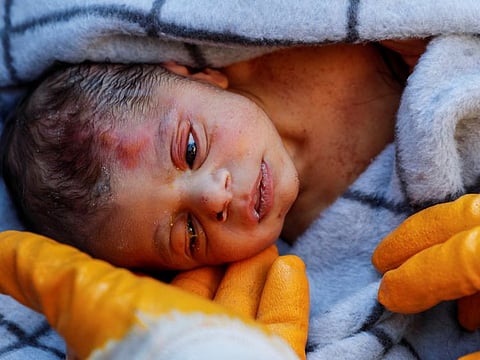Hope fading as deaths in Turkey, Syria quake pass 11,000
Teams from over 25 countries join tens of thousands of locals to search for survivors

GAZIANTEP, Turkey: With the hope of finding survivors fading, stretched rescue teams in Turkey and Syria searched on Wednesday for signs of life in the rubble of thousands of buildings toppled by a catastrophic earthquake.
The confirmed death toll from the world’s deadliest quake in more than a decade passed 11,000.
Turkish President Recep Tayyip Erdogan toured a “tent city” in hard-hit Kahramanmaras where people forced from their homes were living. Amid calls for his government to send more help to the disaster zone, Erdogan conceded initial shortfalls in the response to Monday’s 7.8 magnitude quake but vowed that no one would “be left in the streets.”
Search teams from more than two dozen countries have joined tens of thousands of local emergency personnel on the ground in Syria and Turkey, and aid pledges have poured in from around the world. But the scale of destruction from the earthquake and its powerful aftershocks was so immense and spread over such a wide area, including places isolated by Syria’s ongoing civil war, that many people were still waiting for help.
Experts said the survival window for those trapped under the rubble of collapsed buildings or unable to access water, food, protection from the elements or medical attention was closing rapidly almost three days after the quake.
Rescuers at times used excavators in their searches and picked gingerly through debris at other points to locate survivors or the dead. With thousands of buildings toppled, it was not clear how many people might still be caught in the rubble.
Unidentified to be buried in 5 days
Turkey’s disaster management agency said on Wednesday that people who died in the earthquake but cannot be identified would be buried within five days even if they remained unnamed.
The agency, known as AFAD, said unidentified victims would be buried following DNA tests, finger printing and after being photographed for future identification.
The move is in line with Islamic funeral rites which require a burial to take place as quickly as possible after a person’s death.
In the Turkish city of Malatya, bodies were placed side by side on the ground, covered in blankets, while rescuers waited for funeral vehicles to pick them up, according to former journalist Ozel Pikal, who said he saw eight bodies pulled from the ruins of a building.
Freezing to death
Pikal, who took part in the rescue efforts, said he thinks at least some of the victims froze to death as temperatures dipped to minus 6 degrees Celsius (21 Fahrenheit).
“As of today there is no hope left in Malatya,” Pikal said by telephone. “No one is coming out alive from the rubble.”
Road closures and damage in the region made it hard to access all the areas that need help, he said, and there was a shortage of rescuers where he was. Meanwhile, cold hampered the efforts of those who were there, including volunteers.
“Our hands cannot pick up anything because of the cold,” said Pikal. “Work machines are needed.”
The region was already beset by more than a decade of civil war in Syria that has displaced millions in that country and left them reliant on humanitarian aid and sent millions more to seek refuge in Turkey.
A 2011 earthquake near Japan that triggered a tsunami left nearly 20,000 people dead.
Syrian officials said the bodies of more than 100 Syrians who died during the earthquake in Turkey were brought back home for burial.
Mazen Alloush, an official on the Syrian side of the border, said 20 more bodies were on their way, adding that all of them were Syrian refugees who fled civil war.
Stories of rescues continued to provide hope that some people still trapped might be found alive.
David Alexander, a professor of emergency planning and management at University College London, said data from past earthquakes suggested the likelihood of survival was now slim, particularly for individuals who suffered serious injuries or significant blood loss.
“Statistically, today is the day when we’re going to stop finding people,” he said. “That doesn’t mean we should stop searching.”
Alexander cautioned that the final death toll may not be known for weeks because of the sheer amount of rubble that needs to be sifted.
The last time an earthquake killed so many people was 2015, when 8,800 died in a magnitude 7.8 quake in Nepal. A 2011 earthquake in Japan triggered a tsunami, killing nearly 20,000 people.
Cold weather added to the misery of residents who lost their homes. Many survivors in Turkey slept in cars, government shelters or outdoors.
Erdogan, on this tour of quake-hit areas, acknowledged that there were problems early on in the response but said it had improved.
He said the government would distribute 10,000 Turkish lira ($532) to affected families.
The European Union said Wednesday that Syria had asked for humanitarian assistance to deal with the victims of the devastating earthquake. An EU representative insisted the bloc’s sanctions against the Syrian government had no impact on its potential to help.
On Wednesday, Syrian Prime Minister Hussein Arnous visited neighbuorhoods in the northern city of Aleppo where buildings collapsed because of the earthquake.
“Our priority now is to rescue the people who are still under the rubble,” he said.
Sign up for the Daily Briefing
Get the latest news and updates straight to your inbox


